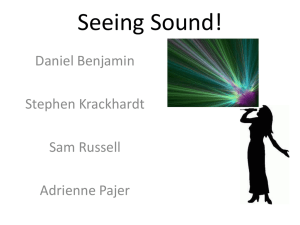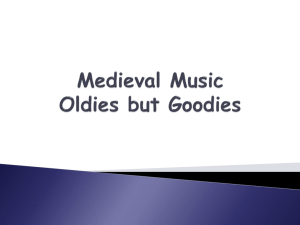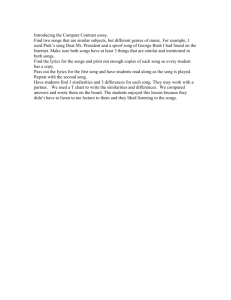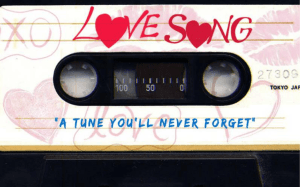2011 IEEE Workshop on Applications of Signal Processing to Audio... October 16-19, 2011, New Paltz, NY
advertisement
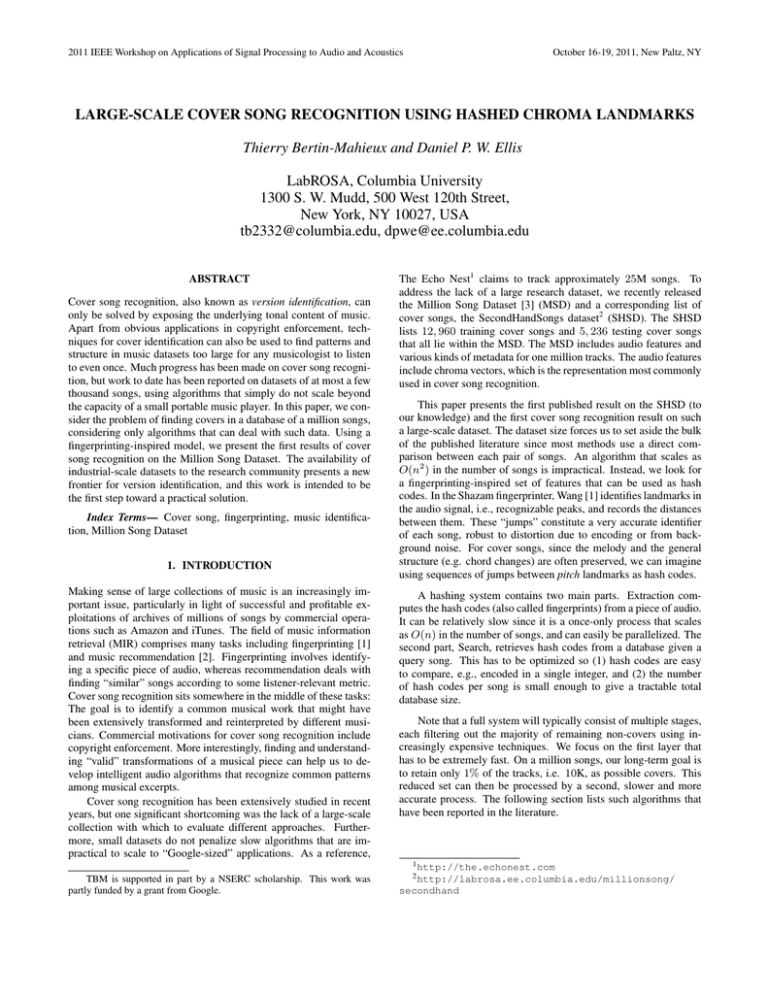
2011 IEEE Workshop on Applications of Signal Processing to Audio and Acoustics
October 16-19, 2011, New Paltz, NY
LARGE-SCALE COVER SONG RECOGNITION USING HASHED CHROMA LANDMARKS
Thierry Bertin-Mahieux and Daniel P. W. Ellis
LabROSA, Columbia University
1300 S. W. Mudd, 500 West 120th Street,
New York, NY 10027, USA
tb2332@columbia.edu, dpwe@ee.columbia.edu
ABSTRACT
Cover song recognition, also known as version identification, can
only be solved by exposing the underlying tonal content of music.
Apart from obvious applications in copyright enforcement, techniques for cover identification can also be used to find patterns and
structure in music datasets too large for any musicologist to listen
to even once. Much progress has been made on cover song recognition, but work to date has been reported on datasets of at most a few
thousand songs, using algorithms that simply do not scale beyond
the capacity of a small portable music player. In this paper, we consider the problem of finding covers in a database of a million songs,
considering only algorithms that can deal with such data. Using a
fingerprinting-inspired model, we present the first results of cover
song recognition on the Million Song Dataset. The availability of
industrial-scale datasets to the research community presents a new
frontier for version identification, and this work is intended to be
the first step toward a practical solution.
Index Terms— Cover song, fingerprinting, music identification, Million Song Dataset
1. INTRODUCTION
Making sense of large collections of music is an increasingly important issue, particularly in light of successful and profitable exploitations of archives of millions of songs by commercial operations such as Amazon and iTunes. The field of music information
retrieval (MIR) comprises many tasks including fingerprinting [1]
and music recommendation [2]. Fingerprinting involves identifying a specific piece of audio, whereas recommendation deals with
finding “similar” songs according to some listener-relevant metric.
Cover song recognition sits somewhere in the middle of these tasks:
The goal is to identify a common musical work that might have
been extensively transformed and reinterpreted by different musicians. Commercial motivations for cover song recognition include
copyright enforcement. More interestingly, finding and understanding “valid” transformations of a musical piece can help us to develop intelligent audio algorithms that recognize common patterns
among musical excerpts.
Cover song recognition has been extensively studied in recent
years, but one significant shortcoming was the lack of a large-scale
collection with which to evaluate different approaches. Furthermore, small datasets do not penalize slow algorithms that are impractical to scale to “Google-sized” applications. As a reference,
The Echo Nest1 claims to track approximately 25M songs. To
address the lack of a large research dataset, we recently released
the Million Song Dataset [3] (MSD) and a corresponding list of
cover songs, the SecondHandSongs dataset2 (SHSD). The SHSD
lists 12, 960 training cover songs and 5, 236 testing cover songs
that all lie within the MSD. The MSD includes audio features and
various kinds of metadata for one million tracks. The audio features
include chroma vectors, which is the representation most commonly
used in cover song recognition.
This paper presents the first published result on the SHSD (to
our knowledge) and the first cover song recognition result on such
a large-scale dataset. The dataset size forces us to set aside the bulk
of the published literature since most methods use a direct comparison between each pair of songs. An algorithm that scales as
O(n2 ) in the number of songs is impractical. Instead, we look for
a fingerprinting-inspired set of features that can be used as hash
codes. In the Shazam fingerprinter, Wang [1] identifies landmarks in
the audio signal, i.e., recognizable peaks, and records the distances
between them. These “jumps” constitute a very accurate identifier
of each song, robust to distortion due to encoding or from background noise. For cover songs, since the melody and the general
structure (e.g. chord changes) are often preserved, we can imagine
using sequences of jumps between pitch landmarks as hash codes.
A hashing system contains two main parts. Extraction computes the hash codes (also called fingerprints) from a piece of audio.
It can be relatively slow since it is a once-only process that scales
as O(n) in the number of songs, and can easily be parallelized. The
second part, Search, retrieves hash codes from a database given a
query song. This has to be optimized so (1) hash codes are easy
to compare, e.g., encoded in a single integer, and (2) the number
of hash codes per song is small enough to give a tractable total
database size.
Note that a full system will typically consist of multiple stages,
each filtering out the majority of remaining non-covers using increasingly expensive techniques. We focus on the first layer that
has to be extremely fast. On a million songs, our long-term goal is
to retain only 1% of the tracks, i.e. 10K, as possible covers. This
reduced set can then be processed by a second, slower and more
accurate process. The following section lists such algorithms that
have been reported in the literature.
1 http://the.echonest.com
TBM is supported in part by a NSERC scholarship. This work was
partly funded by a grant from Google.
2 http://labrosa.ee.columbia.edu/millionsong/
secondhand
2011 IEEE Workshop on Applications of Signal Processing to Audio and Acoustics
2. RELATED WORK
The most complete introduction to cover song recognition can be
found in [4]. State-of-the-art algorithms consist of the 5 steps summarized below:
1. Features extraction: Usually chroma or PCP. Some methods
try to extract the melody or the chords.
2. Key invariance: A cover song can be performed in a different
key. With chroma features, this means that the cover can
have identical features up to a rotation on the chroma axis.
3. Tempo invariance: Using beat tracking or dynamic time
warping to compute features on musically-relevant time
frames, invariant in a slower or faster interpretation.
4. Structure invariance: An optional step, one can search, for
instance, for repeated patterns, thus further abstracting the
representation.
5. Similarity computation: Dynamic programming alignment,
or some simpler distance if the structure invariance step simplified the data enough.
Later in this paper, we provide a partial comparison with the method
from [5] that follows this 5-step structure.
One can see that the final alignment step has a time complexity
of O(n2 ) where n is the number of songs in the database. This is
a prohibitive step when working with the MSD. Some researchers
have proposed the use of hashing, which circumvents this problem.
Pioneering work include [6, 7], but none of this previous work uses
datasets larger than a few thousand tracks – far smaller than the
MSD.
10
8
6
4
2
0
0
50
100
150
200
250
300
350
Figure 1: Beat-aligned chromas of the song “Wild Rover” by Dropkick Murphys.
3. HASHING SYSTEM
In this Section we present the core of the algorithm, i.e., how to
move from a chroma matrix to a relatively small set of integers for
each song.
3.1. Data representation
The feature analysis used throughout this work is based on Echo
Nest analyze API [8]. A chromagram (Figure 1) is similar in spirit
to a constant-Q spectrogram except that pitch content is folded into
a single octave of 12 discrete bins, each corresponding to a particular semitone (i.e., one key on a piano). For each song in the MSD,
the Echo Nest analyzer gives a chroma vector (length 12) for every music event (called “segment”), and a segmentation of the song
into beats. Beats may span or subdivide segments. Averaging the
per-segment chroma over beat times results in a beat-synchronous
chroma feature representation similar to that used in [5]. The beatsynchronous chroma feature representation corresponds to the 3rd
step from Section 2.
October 16-19, 2011, New Paltz, NY
The most appropriate normalization for chroma vectors is not
obvious. For instance, should we divide each column by its maximum value, or should we take into account segment loudness (another attribute provided by The Echo Nest analyzer)? In this work
we normalize by the max, and we do not use loudness, but these
choices were made empirically and may not give the best performance with other algorithms.
3.2. Hash codes
Having calculated the normalized beat-synchronous chroma matrix,
we first average the chroma over pairs of successive beats, which
reduced dimensionality without impacting performance in our experiments. We then identify landmarks, i.e. “prominent” bins in the
resulting chroma matrix. We use an adaptive threshold as follow:
• Initialize threshold vector Ti0 , i = 1 . . . 12 as the maximum in
each chroma dimension over the first 10 time frames (of two
beats each).
• At time t, accept a bin as a landmark if its value is above the
threshold. Let v be the value of this landmark and c be its
chroma bin index. Then we set Tct = v. We limit the number
of landmarks per time frame to 2.
• Moving from t to t + 1, we use a decay factor ψ to update the
threshold: Tit+1 = ψTit .
We calculate landmarks through a forward and a backward pass,
and keep the intersection, i.e., landmarks identified in both passes.
We then look at all possible combinations, i.e., set of jumps between
landmarks, over a window of size W . To avoid non-informative duplicates, we only consider forward jumps, or in one direction within
a same time frame.
Landmark pairs provide information relating to musical objects
such as chords and changes in the melody line; For clarity, we refer
to them as “jumpcodes”: A jumpcode consists of an initial chroma
value plus a list of differences in time and chroma between successive landmarks. If we had 3 landmarks at (time, chroma) positions
(200, 2), (201, 7) and (204, 3) in the beat-aligned chroma representation (and a window length W of at least 5), the jumpcode would
be {2, ((1, 5), (3, 8))}. Note that for convenience, we take the jump
between chroma bins modulo 12. The complete set of jumpcodes is
characteristic of the song, and hopefully also of its covers. Figure 2
shows the landmark jumps for several versions of a single composition.
In this work, we do not exploit the position of the jumpcodes
in the song. It might be useful to consider ordered sets of jumpcodes to identify cover songs, but this additional level of complexity would be computationally expensive. Also, covers versions frequently alter the coarse-scale structure of a composition, so global
consistency is not preserved.
3.3. Encoding and Retrieval
The jumpcodes of all reference items are stored in a database to
facilitate search. We use SQLite, and like any other database, it
is more efficient to encode jumpcodes as a single integer. Many
scheme can be devised; we use the following to allow us to easily
compute a “transposed jumpcode”, i.e. the jumpcode for a song
rotated on its chroma axis. Such rotation is important to be able to
match cover songs that are not performed in the same key.
Given a set of k (time, chroma) landmarks within a time window of size W , (t1 c1 ), (t2 c2 ), ...(tk ck ), we use arithmetic and delta
2011 IEEE Workshop on Applications of Signal Processing to Audio and Acoustics
10
8
6
4
2
0
0
10
8
6
4
2
0
0
10
8
6
4
2
0
0
10
8
6
4
2
0
0
4.1. SecondHandSong dataset
%4173, Come Softly To Me
50
100
50
50
50
150
100
200
150
100
100
250
200
150
150
October 16-19, 2011, New Paltz, NY
300
250
200
200
250
250
Figure 2: Landmarks and jumpcodes for the 4 cover songs of the
work %4173 from the SHSD. We use the settings from “jumpcodes
2”, see Table 1. In this example, the jumpcodes seem to mostly
follow the melody.
coding to store these in a single value:
H = c1 + 12((t2 − t1 ) + W ((c2 − c1 )
+ 12((t3 − t2 ) + W ((c3 − c2 )
+ ...
+ 12((tk − tk−1 ) + W ((ck − ck−1 )))))))
(1)
The most important feature of this scheme is that the initial chroma
value can be retrieved via the modulo operation hHi12 . This lets
us transpose a jumpcode, i.e., construct the jumpcode we would get
if the song was performed in another key, by extracting the initial
chroma c1 , and adding rotation value between 0 and 11 (modulo
12) prior to recombination.
Empirically, we observe that some songs generate more jumpcodes than others (including duplicates). To avoid this biasing retrieval, we assign a weight to each jumpcode based on the number of
times it appears in the song divided by the log (base 10) of the total
number of jumpcodes in that song. The use of log is empiricallybased, but the intuition is that it diminishes the importance of jumpcodes that appear often, if they occur in a larger pool.
For the retrieval phase, we have all jumpcodes (with positive
weights) for all songs in the database. Given a query song, we get
all pairs (song, jumpcode) for which (1) the jumpcode also belongs
to the query song, and (2) the weight of that jumpcode falls within a
margin around the weight of that jumpcode in the query song. The
margin is computed given a factor α as (1 − α)weightquery ≤
weight ≤ (1 + α)weightquery . Once all the pairs from all jumpcodes in the query song have been retrieved, reference songs are
ranked in likelihood of being cover versions of the query based on
the number of times they appear in a matched pair.
One peculiarity of cover song recognition is that the target
might be in another key. Thus, for each query, we perform 12 independent queries, one per transposition. As explained above, transposing the query’s jumpcodes is computationally efficient.
4. EXPERIMENTS
After a brief description of the dataset, we present the results of our
experiments.
The SecondHandSongs dataset (SHSD) was created by matching
the MSD with the database from www.secondhandsongs.com
that aggregates user-submitted cover songs. It is arbitrarily divided
in to training and test sets. The SHSD training set contains 12, 960
cover songs from 4, 128 cliques (musical works), and the test set
has 5, 236 tracks in 726 cliques. Note that we use the term “cover”
in a wide sense. For instance, two songs derived from the same
original work are considered covers of one another. In the training
set of the SHSD, the average number of beats per song is 451 with
a standard deviation of 224.
4.2. Training
To simplify the search within algorithm parameters, we created a
set of 500 binary tasks out of the 12, 960 songs from the training
set. From a query, our algorithm had to choose the correct cover between two possibilities. The exact list of triplets we used are available on the project’s website. We overfit this 500-queries subset
through many quick experiments in order to come up with a proper
setting of the parameters (although given the size of the parameter space, it is entirely possible that we missed a setting that would
greatly improve results). Parameters include the normalization of
beat-chroma (including loudness or not), the window length W , the
maximum number of landmarks per beat, the length (in number of
landmarks) of the jumpcodes, the weighting scheme of the hash
codes, the allowed margin α around a jumpcode weight, the decay
ψ of the threshold envelope, etc. We present the best settings we
found to serve as a reference point for future researchers.
4.3. Results
We first present our results on the 500-queries subset. We report
two settings for the jumpcodes. This first, called “jumpcodes 1”,
gave the best results on the 500-pair task and used the following
parameters: ψ = 0.96, W = 6, α = 0.5, number of landmarks per
jumpcode: 1 and 4, chroma vectors aligned to each beat. Unfortunately, it generated too many jumpcodes per song to be practical.
The parameters for “jumpcodes 2” were: ψ = 0.995, W = 3,
α = 0.6, number of landmarks per jumpcode: 3, chroma aligned to
every 2 beats. The results are presented Table 1, where accuracy is
simply the number of times the true cover was selected. Note the
drop from 11, 794 to 176 jumpcodes on average per song between
the two parameter sets.
As a comparison, we also report the accuracy from the published algorithm in [5], called “correlation” in the Table. This
method computes the global correlation between beat-aligned
chroma representations, including rotations and time offsets. We
conclude that our current method performs similarly – the subset
is too small to claim more than this. Since this binary task seems
much easier than the 1-in-N task in [5], we expected a higher baseline; perhaps the cover songs are rather difficult in this subset, or
possibly the chroma representation from The Echo Nest is less useful for cover recognition than the one in [5].
Our next experiment tested how our settings would translate to
a larger set, namely the 12, 960 training cover songs. For now on we
report the average rank of the target covers for each query. On the
subset, using the settings from “jumpcode 2”, the average position
was 4, 361. If we think of a query as doing 12, 960 binary decision,
this gives us an accuracy of 66.3%. We have 2, 280, 031 (song,
2011 IEEE Workshop on Applications of Signal Processing to Audio and Acoustics
random
jumpcodes 1
jumpcodes 2
correlation
accuracy
50.0%
79.8%
77.4%
76.6%
#hashes
11, 794
176
-
Table 1: Results on the 500-queries subset. The #hashes fields represents, on average, the number of jumpcodes we get per track.
October 16-19, 2011, New Paltz, NY
ber of jumpcodes in the query and the number of reference songs
matching each jumpcode.
Implementation-wise, we probably pushed SQLite outside its
comfort zone. We could not index the ∼ 150M jumpcodes in one
table. We created ∼ 300K tables, one per jumpcode. Since a typical query had between 1, 000 and 2, 000 jumpcodes (including rotations), only a small proportion of these tables were used in any
single query.
5. CONCLUSION AND FUTURE WORK
jumpcode) pairs in the database for the training songs, giving us an
average of 176 jumpcodes per track.
Finally, over the whole MillionSsong Dataset, using the SHSD
test set, we get an average rank of 308, 369 with a standard deviation of 277, 697. To our knowledge, this is the first reported result
on this dataset, or any such large-scale data.
Rankings of top 1704 out of 17772 cover songs in MillionSongDataset
140
120
count
100
80
60
40
20
0
0
2000
4000
6000
8000
We achieved our aim of providing a first benchmark result on
the full SHSD / MSD collection. We have made available our
code, training lists, and results so that other researchers can easily reproduce the results: see http://www.columbia.edu/
˜tb2332/proj/coversongs.html.
While the results reported here may not look as impressive as
previously published numbers based on smaller sets, we emphasize
that the scale of the database necessitated a much less precise approach; final accuracy could be improved by subsequent layers of
search on the potential matches found in this first stage. We see this
large-scale dataset as an opportunity: For cover song recognition, it
gives us the data to learn a similarity metric instead of guessing one.
For other music information retrieval tasks, many of which can be
performed on the MSD, we hope that patterns learned from cover
recognition can lead to better algorithms for recommendation and
classification, etc. This work is a first step in that direction.
10000
rank
6. REFERENCES
Figure 3: Histogram of the rankings of the 1, 704 query pairs whose
rank is below 10, 000.
[1] A. Wang, “An industrial strength audio search algorithm,” in
Proceedings of the 4th International Conference on Music Information Retrieval (ISMIR 2003), 2003.
The large standard deviation hints that some covers are ranked
much better than average. Figure 3 shows a histogram of the rankings of the 1, 704 out of 17, 772 queries (9.6%) whose target covers were ranked in the top 1% (10, 000 tracks) of the million songs
in this evaluation. The bin width is 100 rank positions. We see
that 120 tracks (0.68% of queries) ranked at 100th or better (top
0.01%); a random baseline would be expected to place fewer than
2 of the 17, 772 queries at this level. In fact, 12 query tracks ranked
their matches at #1 in a million tracks. Some of these turned out
to be actual duplicates, an existing problem of the MSD3 . But most
are genuine covers, such as the query “Wuthering Heights” by Kate
Bush matching a version by Hayley Westenra, or “I don’t like Mondays” by The Boomtown Rats retrieving a live version by Bon Jovi
(with Bob Geldof of the Boomtown Rats performing guest vocals,
recorded 16 years after the original).
[2] D. Eck, P. Lamere, T. Bertin-Mahieux, and S. Green, “Automatic generation of social tags for music recommendation,” in
Advances in Neural Information Processing Systems 20. Cambridge, MA: MIT Press, 2008.
4.4. Time and Implementation Considerations
Our goal was to construct a cover song detector able to search a
million songs in a “reasonable time”, which eventually meant less
than a week on a few CPUs. Computing the jumpcodes for the
entire MSD took about 3 days using 5 CPUs, or a little over 1 CPUsecond per track (starting from the Echo Nest chroma features). A
typical query takes less than a second per transposition to match
against the full MSD. Factors influencing query time are the num3 http://labrosa.ee.columbia.edu/millionsong/
blog/11-3-15-921810-song-dataset-duplicates
[3] T. Bertin-Mahieux, D. Ellis, B. Whitman, and P. Lamere, “The
million song dataset,” in Proceedings of the 11th International
Society for Music Information Retrieval Conference (ISMIR
2011), 2011, (submitted).
[4] J. Serrà, “Identification of versions of the same musical composition by processing audio descriptions,” Ph.D. dissertation,
Universitat Pompeu Fabra, Barcelona, 2011.
[5] D. Ellis and G. Poliner, “Identifying cover songs with chroma
features and dynamic programming beat tracking,” in Proceedings of the 2007 International Conference on Acoustics, Speech
and Signal Processing (ICASSP). IEEE Signal Processing Society, 2007.
[6] M. Casey and M. Slaney, “Fast recognition of remixed music
audio,” in Proceedings of the 2007 International Conference
on Acoustics, Speech and Signal Processing (ICASSP). IEEE
Signal Processing Society, 2007.
[7] S. Kim and S. Narayanan, “Dynamic chroma feature vectors
with applications to cover song identification,” in Multimedia
Signal Processing, 2008 IEEE 10th Workshop on. IEEE, 2008,
pp. 984–987.
[8] The Echo Nest Analyze, API, http://developer.echonest.com.

